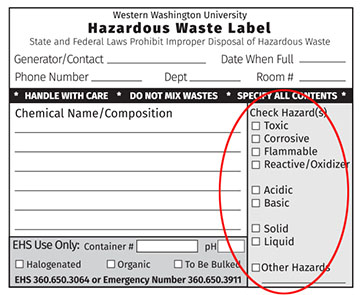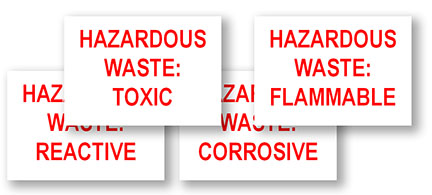Chemical Waste
WASTE DISPOSAL
Chemical wastes or chemicals that are surplus or no longer wanted may be disposed of through the EHS office. To dispose of chemical wastes, you will need to complete an online Hazardous Waste/Surplus Chemical Collection Request and submit it to EHS for pickup. To gain access to the Hazardous Waste Collection Request, you must first contact EHS by email at ehs@wwu.edu or phone at (360) 650-3064 and ask to be added to the Hazardous Waste Request roster. Once that is done and you have logged into the Collection Request form, you will see a yellow "Submit a Request" link in the bottom left hand corner. Clicking that link will bring you to the form where you can list yours wastes and submit to EHS for collection. If you have any questions regarding this process or for more information on training and waste disposal, please contact EHS by email at ehs@wwu.edu or phone at (360) 650-3064.
WASTE LABELING
All waste containers MUST be labeled at all times with a completed Hazardous Waste Label as shown below. Within the label there are fields to be completed that include:
- Generator Name
- Contact Phone Number
- Department
- Room Number
- Chemical Composition
- Hazards


One line on the Hazardous Waste Label that SHOULD NOT be completed until the container is ready for pickup/disposal is "Date When Full". This field should only be filled in when the container is full or is ready for pickup/disposal. Once this date is filled, the waste must be picked up by EHS within 3-days. Any greater time than that will be a violation.
The hazardous waste label should be affixed to the container and filled out completely with all contents clearly identified and all appropriate hazard boxes must be checked. If you are not sure what hazards are associated with your waste you can check either the SDS or contact EHS by email at ehs@wwu.edu or phone at (360) 650-3064.
The following labels can be printed out on AVERY 5164 (or equivalent) sized labels.
OVERSIZE WASTE CONTAINER LABELING
If the container you are using is larger than 4L, there is a secondary requirement for placement of oversize labels as well. These oversize labels provide a hazard warning for the container that can be seen at a distance. All oversized containers must have a TOXIC label. After that, apply other oversize labels as appropriate to the waste your are disposing: FLAMMABLE, CORROSIVE or REACTIVE. If you are not sure what hazards are associated with your waste you can check either the SDS or contact EHS by email at ehs@wwu.edu or phone at (360) 650-3064.
The following labels can be printed out on AVERY 5164 (or equivalent) sized labels.
- Toxic Oversize Hazardous Waste Label
- Corrosive Oversize Hazardous Waste Label
- Flammable Oversize Hazardous Waste Label
- Reactive Oversize Hazardous Waste Label
WASTE STORAGE
There are some requirements listed below for waste storage in your lab or workspace. These come directly from the Department of Ecology and are items that we will be considered for compliance during a DOE inspection. As such, it is VERY IMPORTANT that we follow these requirements as best we can.
- All waste must be capped at all times (Eco-funnels are fine but the caps should be closed when not adding waste to the container)
- All waste must be stored in secondary containment at all times
- All waste must have a completed Hazardous Waste Label at all times
- If appropriate, oversize containers (>4L) must have oversize Waste Label(s) at all times
- A bottle is considered FULL if it is at 80% capacity and it should be sent for pickup/disposal
- Waste should be stored only in a Waste Hood
- Waste can be collected in a Working Hood but that waste must be transferred or moved to a Waste Hood at the end of each day
TRAINING
Every WWU faculty or staff member using chemicals and/or generating hazardous waste needs to complete annual training to comply with federal and state regulation. The Laboratory Safety Training Canvas course includes the following training elements:
- Chemical safety, including hazard communication and laboratory safety
- Hazardous waste
- Chemical transportation safety
- Personal protective equipment
- Stormwater protection
Students using chemicals and/or engaging in independent research where they creates hazardous waste streams need to comply with this training requirement as well. Students may receive department-based training. If not, students should contact their instructor to determine the appropriate method of training.
Access the Laboratory Safety Training from our Training Page
